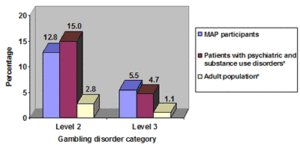Editors’ Note: Next week, The WAGER will feature a research review co-written by Tony Donato and special guest author Lynda Bolt. Lynda is an intern at the Harvard Medical School Division on Addictions (DOA) and will be graduating from the St. Francis House Moving Ahead Program (MAP) on March 28. The DOA was honored to be a part of this internship program, which Lynda initiated as part of her MAP activities. In addition to gaining knowledge about academic research, Lynda also spent time writing an autobiographical article that we will post on the DOA website next week; she hopes this will help others to recover from addiction. We will provide a link to this article.
Finally, for the next two weeks, The WAGER will feature work about addiction and homelessness; we hope that you find this two-week series interesting and informative. We look forward to your feedback.
Debi LaPlante & Howard Shaffer
Among the Homeless, Gambling Disorders Run High High
Rates of substance abuse and psychiatric illness often compound the multiple health problems experienced by homeless persons (Morris & Crystal, 1989; Sebastian, 1985). In view of the fact that substance abuse and psychiatric illness frequently have been linked to higher rates of pathological gambling, Shaffer, Freed, and Healea (2002) hypothesized that the homeless might have a high risk for gambling problems. This week’s WAGER summarizes the findings from Shaffer et al., the first published study of problem gambling prevalence rates among the recently homeless.
Between 1998 and 2000, Shaffer et al. examined the intake information from 171 consecutive homeless persons entering the St. Francis Moving Ahead Program (MAP). MAP is a Boston-based education program designed to provide daily living and work skills to individuals recently challenged by substance abuse and homelessness. All subjects were over 18, recently homeless, and had a history of substance abuse. MAP staff administered the DSM-IV subscale of the Massachusetts Gambling Screen (MAGS, Shaffer, LaBrie, Scanlan, & Cummings, 1994) during intake to the program. Seven subjects did not provide complete information and were excluded from the analyses. In this study, Shaffer et al. found the prevalence of level 2 (subclinical) and level 3 (meet diagnostic criteria for pathological gambling) gambling among homeless subjects was 12.8% and 5.5%, respectively. As figure 1 illustrates, the prevalence of gambling problems among this homeless sample is similar to the prevalence among patients with psychiatric and substance use disorders and much higher than the rate of gambling disorders among the general adult population. Overall, 52% of the homeless subjects reported a history of psychiatric treatment. Homeless subjects who had level 3 gambling disorders were more likely to have received psychiatric treatment than the non-level 3 gamblers.
Figure 1. Past-year prevalence of gambling disordersamong population segments
*Estimates derived from Shaffer, Hall and Vander Bilt (1997; 1999)
It is important to note the limited scope of the study. The researchers sampled a specific population (i.e., treatment seekers in an educational program for homeless substance abusers) which might have unique characteristics; therefore, these findings might not generalize to other homeless populations. Additionally, the researchers did not take advantage of a key opportunity to evaluate the extent to which problem gambling might have contributed to the participants’ homelessness. Future studies might explore this association by asking participants about factors they believe contributed to their homelessness, including gambling-associated debts.
Despite the study’s shortcomings, the data suggest that disordered gamblers might be disproportionately represented in certain homeless populations. This presents treatment providers with a unique set of challenges. The limited economic resources of homeless people affect their ability to cope with health problems, and they often are without ready access to health services. Furthermore, given their limited resources, clinicians often fail to screen the homeless for gambling-related problems, incorrectly assuming that poverty precludes gambling. This study demonstrates the importance of screening for gambling disorders among the homeless. Finally, engaging this population in treatment might necessitate the development of targeted outreach programs and new screening procedures.
Comments on this article can be addressed to Rachel Kidman.
References
Morris, W., & Crystal, S. (1989). Diagnostic patterns in hospital use by an urban homeless population. Western Journal of Medicine, 151(4), 472-476. Sebastian, J. G. (1985). Homelessness: a state of vulnerability. Family and Community Health, 8(3), 11- 24.
Shaffer, H., LaBrie, R., Scanlan, K. M., & Cummings, T. N. (1994). Pathological Gambling Among Adolescents: Massachusetts Adolescent Gambling Screen (MAGS). Journal of Gambling Studies, 10, 339-362. Shaffer, H. J., Freed, C. R., & Healea, D. (2002). Gambling disorders among homeless persons with substance use disorders seeking treatment at a community center. Psychiatric Services, 55(9), 1112- 1117.
Shaffer, H. J., Hall, M. N., & Vander Bilt, J. (1997). Estimating the prevalence of disordered gambling behavior in the United States and Canada: a metaanalysis. Boston: Presidents and Fellows of Harvard College.
Shaffer, H. J., Hall, M. N., & Vander Bilt, J. (1999). Estimating the prevalence of disordered gambling behavior in the United States and Canada: a research synthesis. American Journal of Public Health, 89, 1369-1376.





